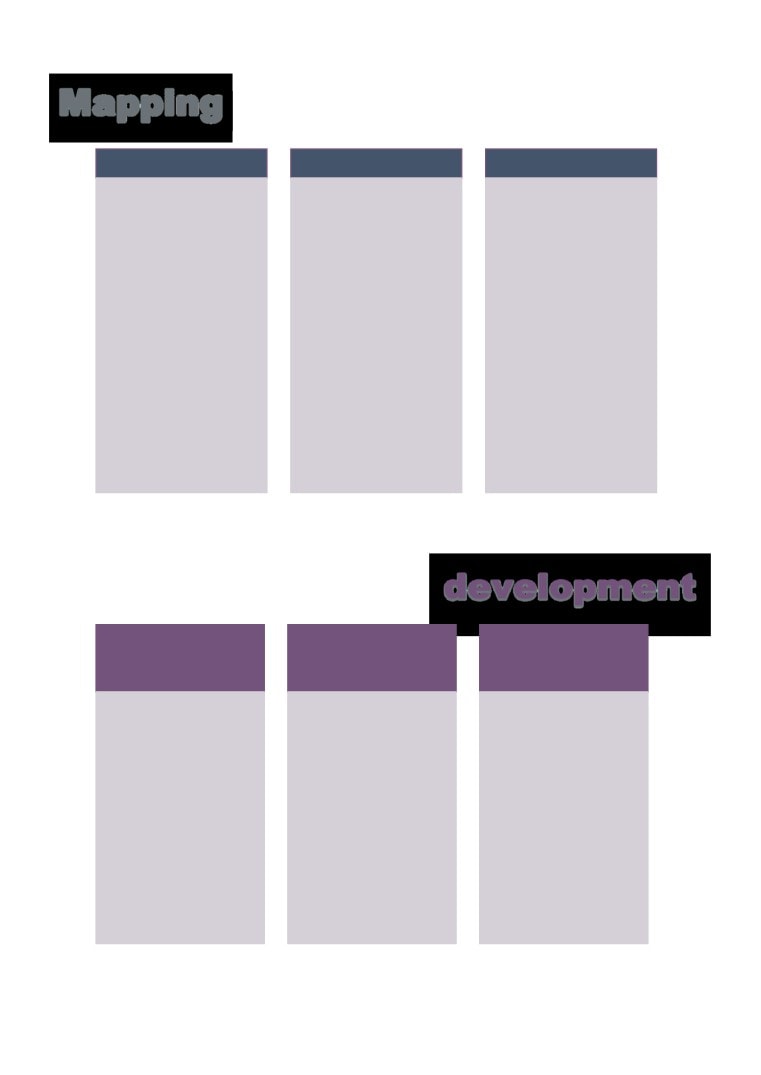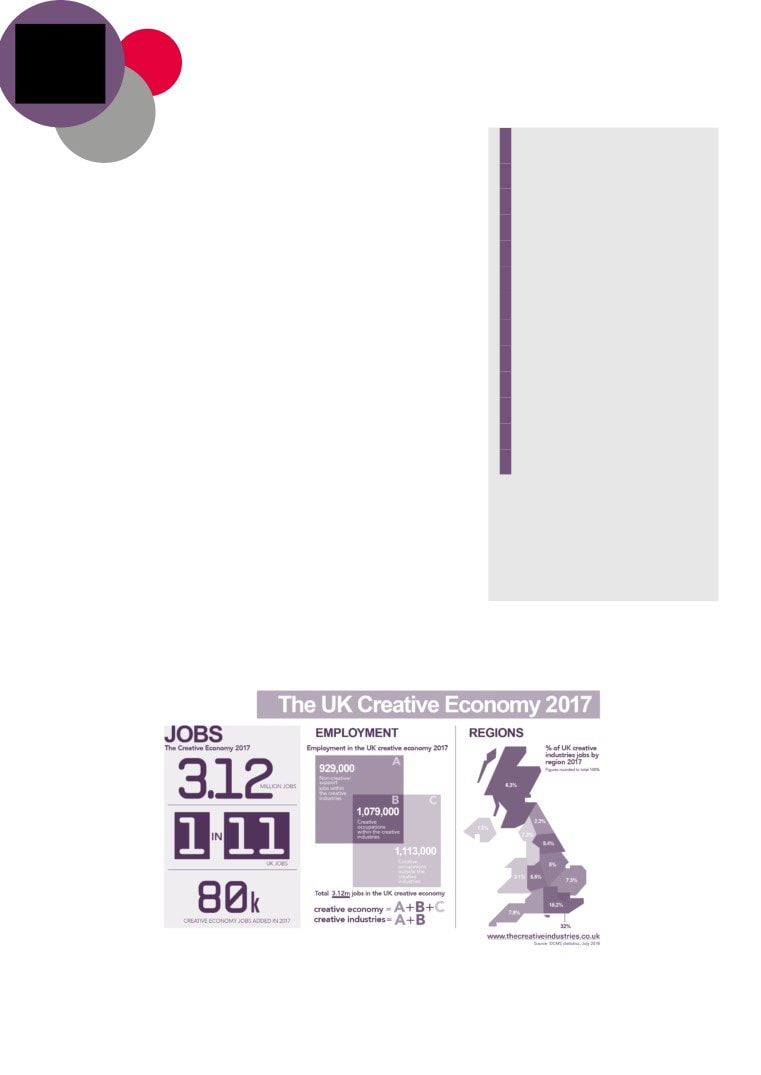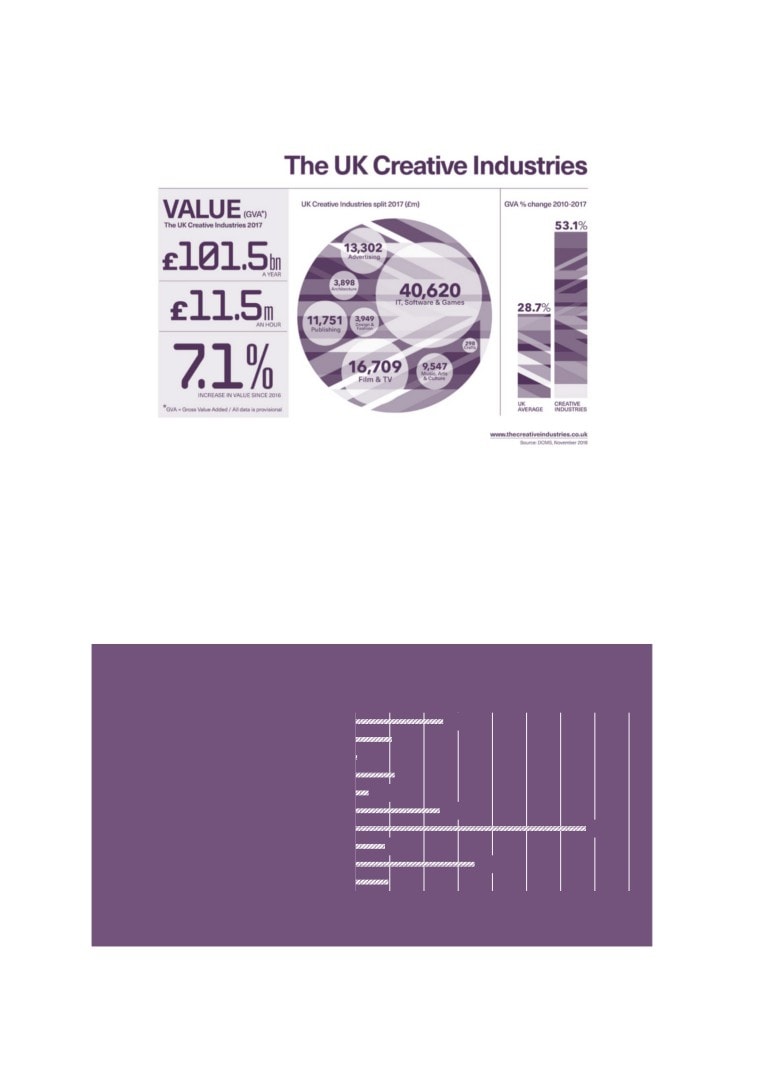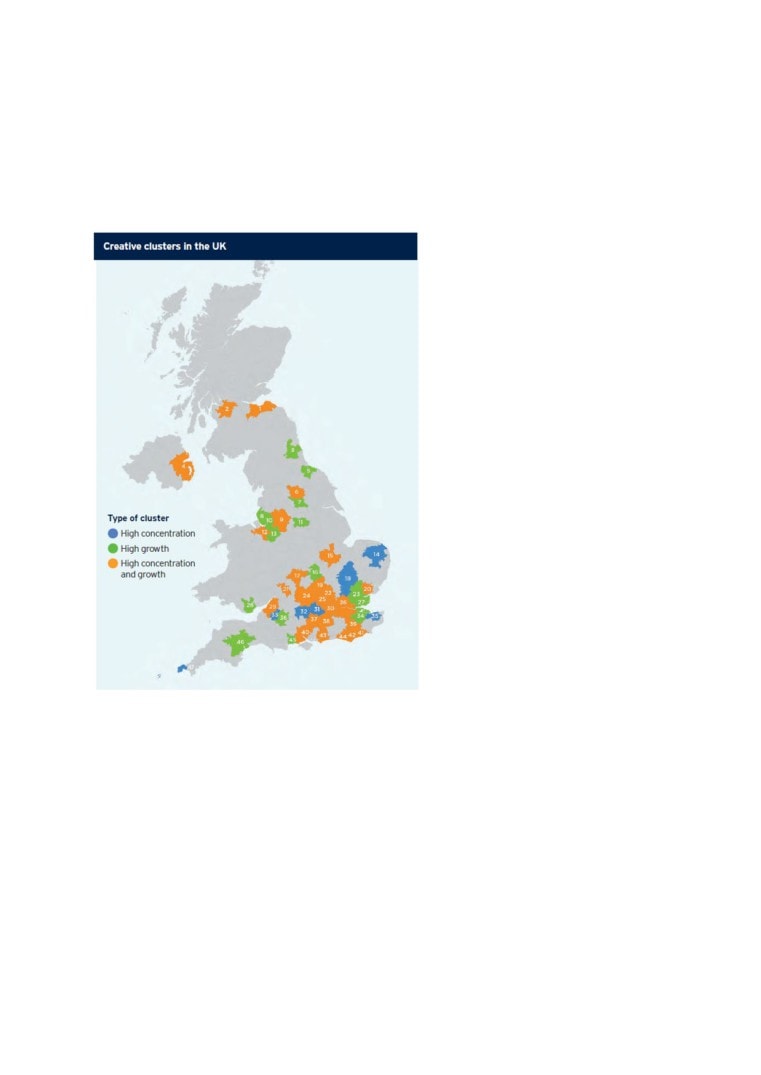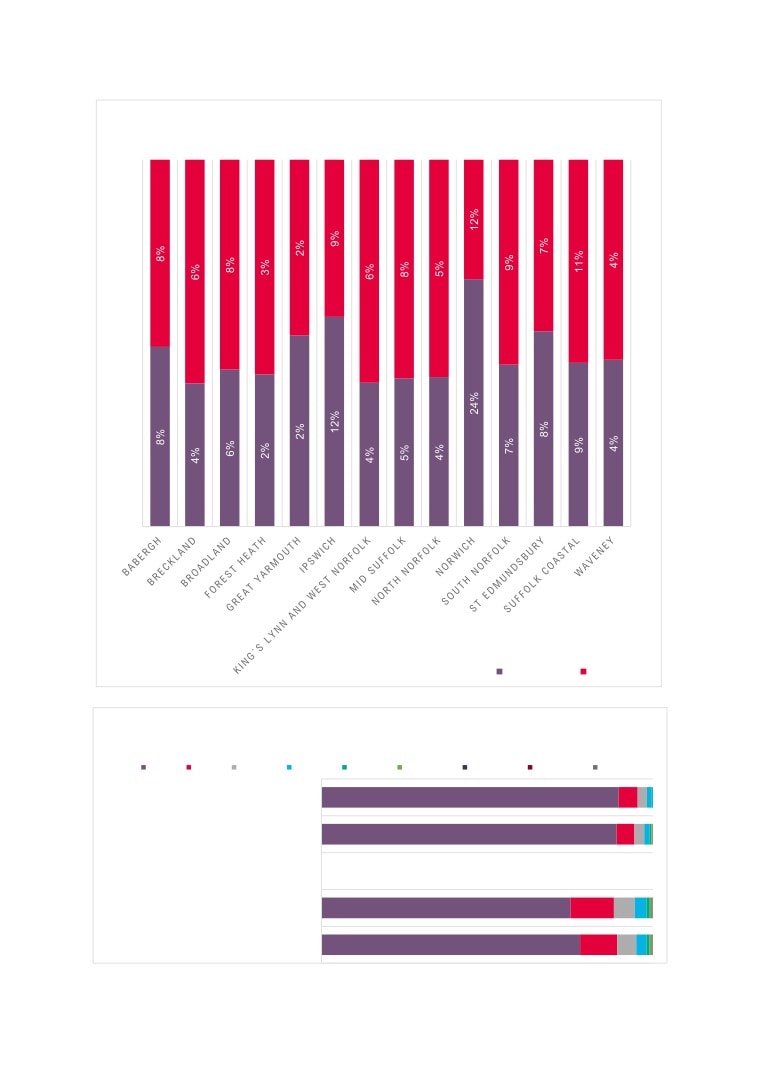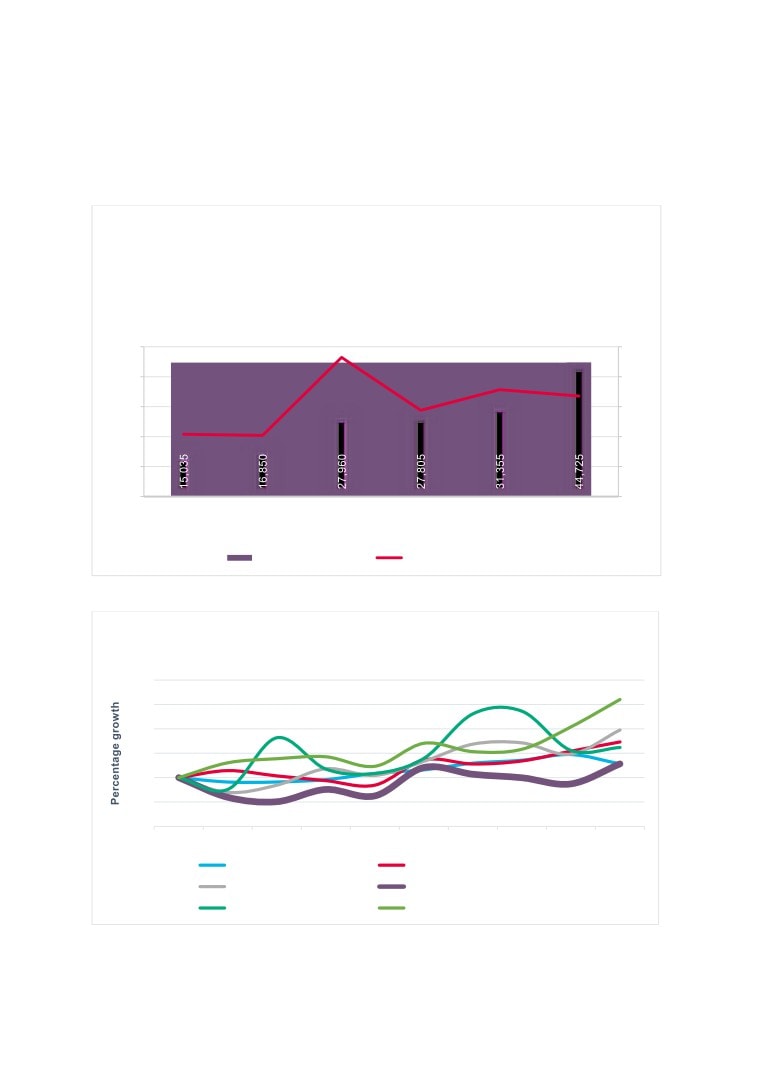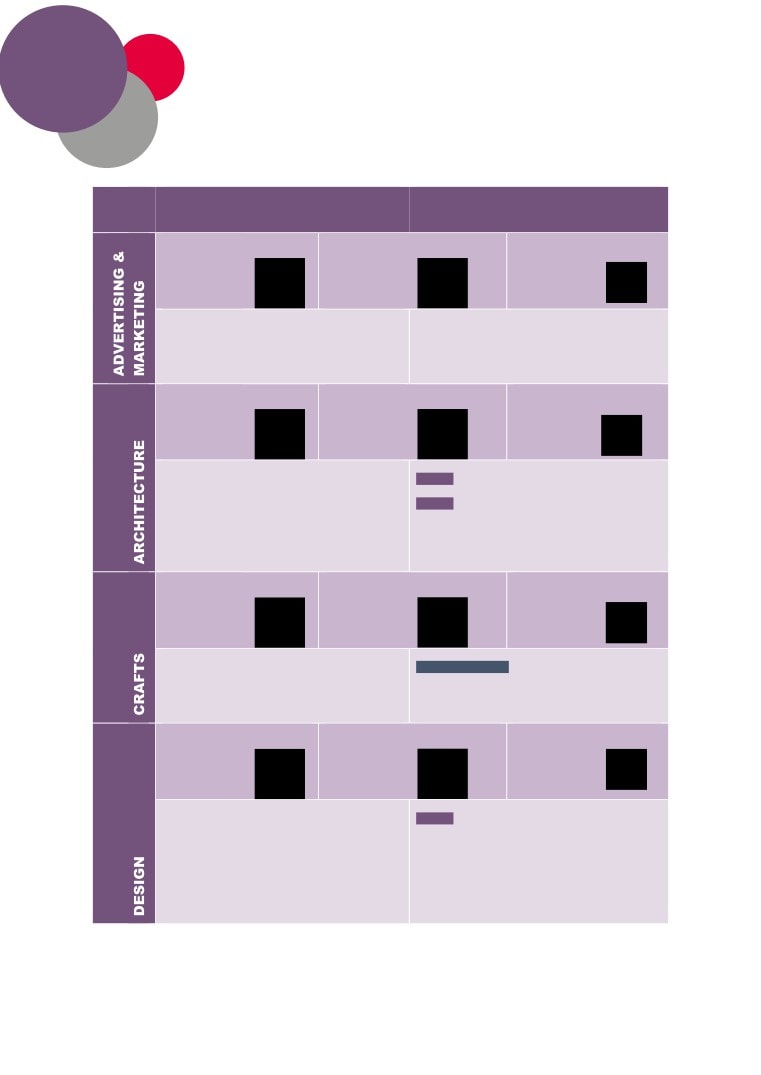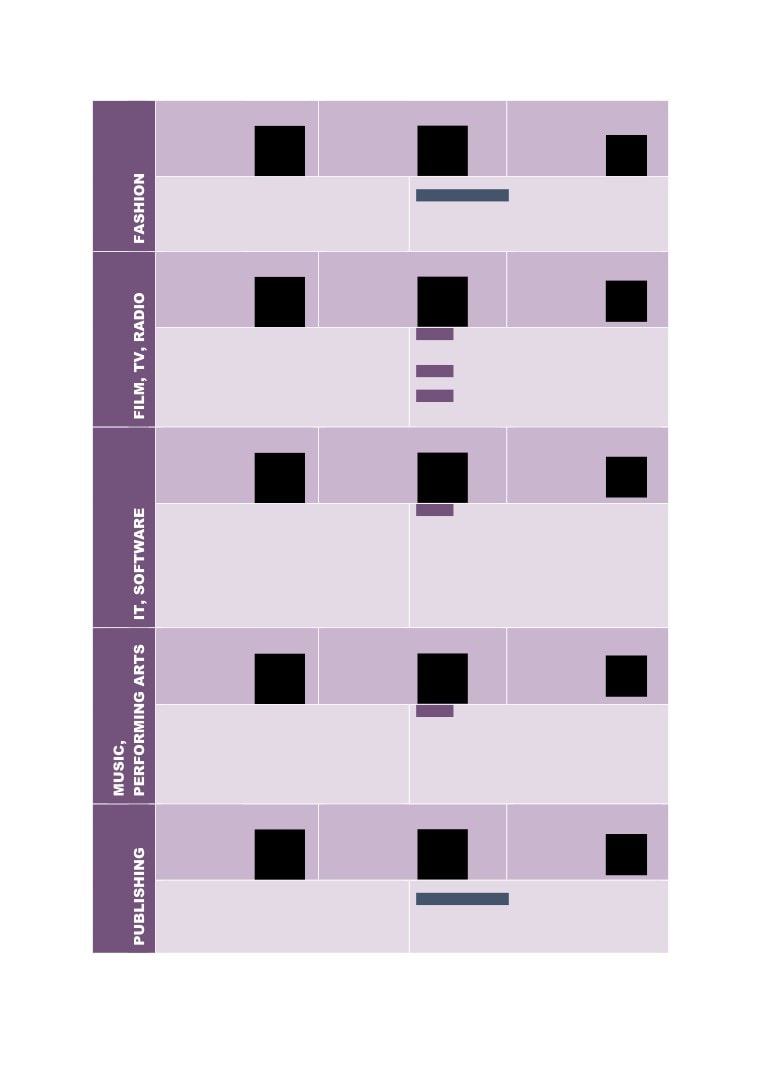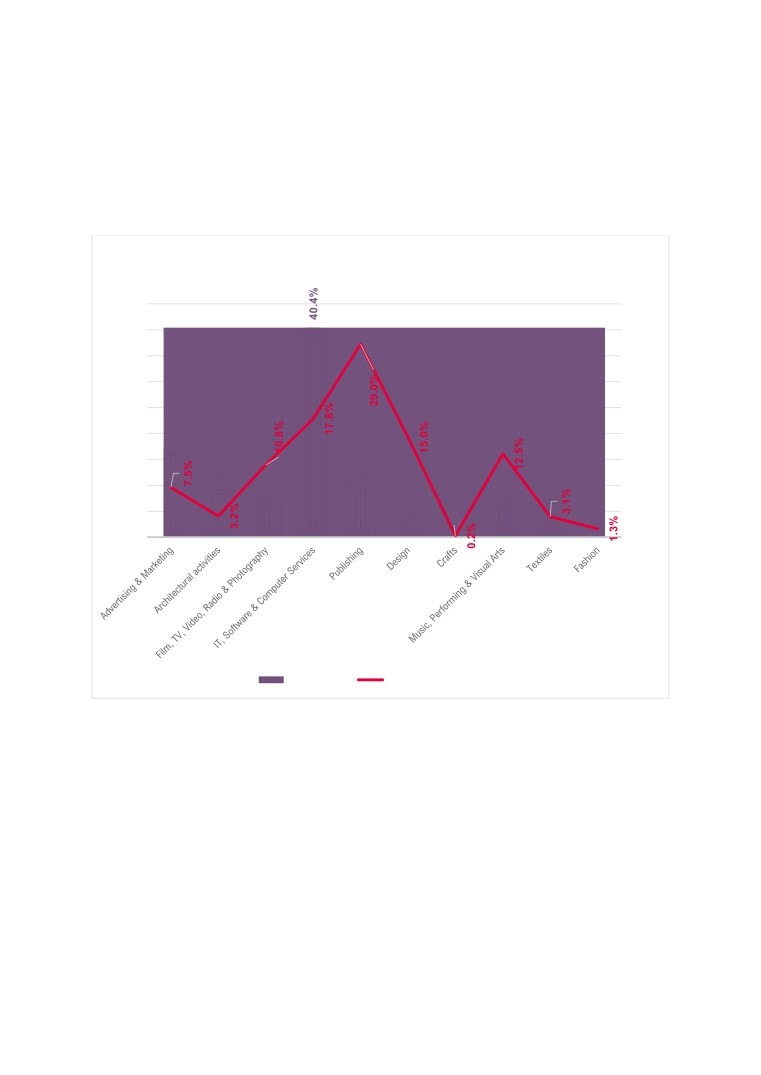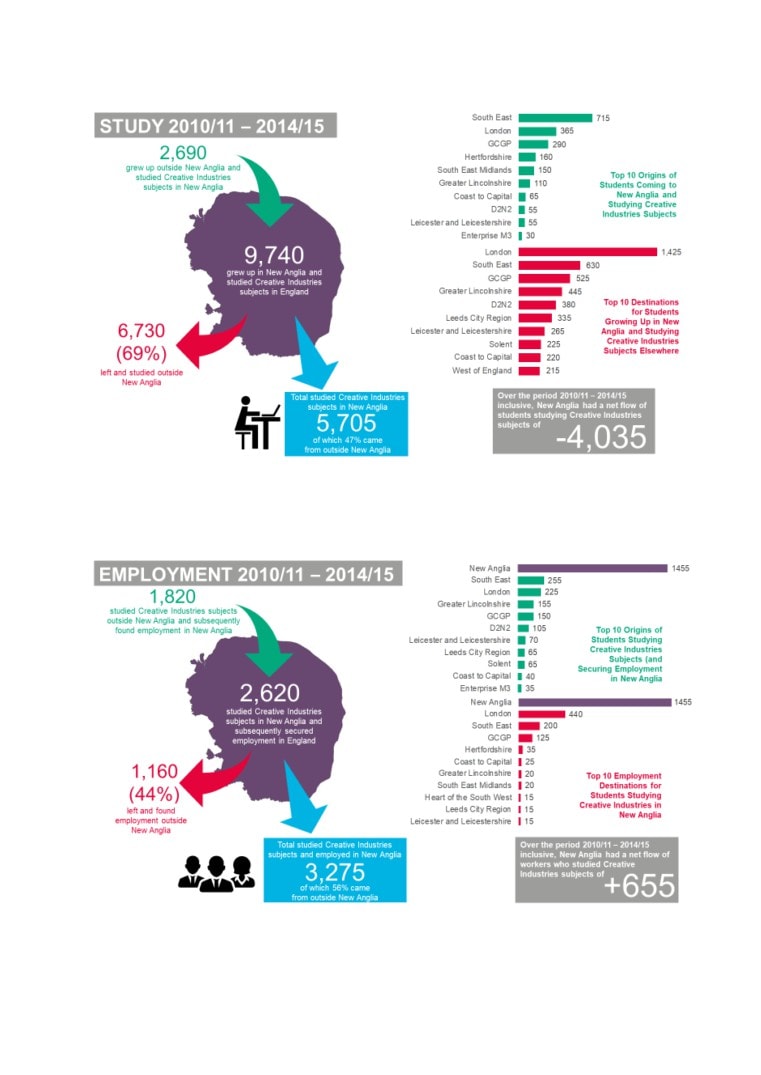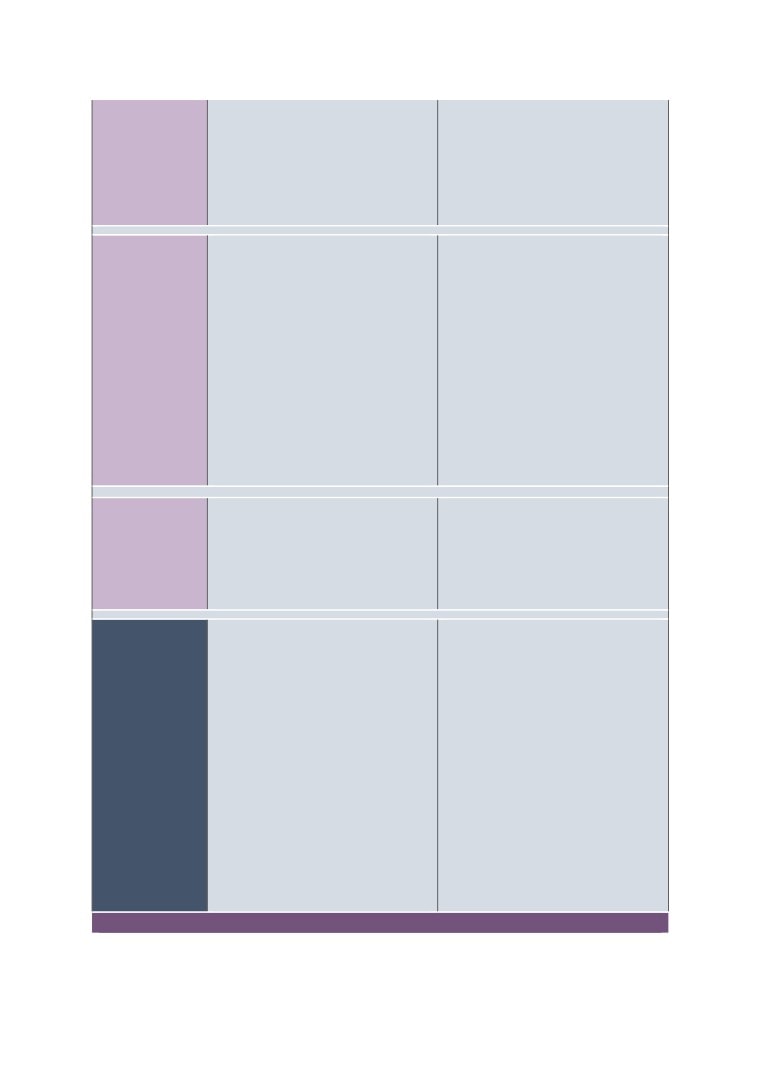Final Version for LEP Officers : Confidential. 14 Feb 2019
Enabling Growth in the New
Anglia Creative Industries
Sector through Skills
Development
Creative Industries Sector Skills Plan
Version for New Anglia Skills Board
CONFIDENTIAL
28 February 2019
F
BACKGROUND CONTEXT
The development of this Creative
Industries Skills Plan has been led by the
New Anglia Creative Industries Group
working alongside the New Anglia Local
Enterprise Partnership, the New Anglia
Skills Board and supported by
SkillsReach.
SkillsReach was contracted to facilitate
and prepare sector skills plans for the New
Anglia LEP priority sectors. The project
was commissioned by the Education and
Skills Funding Agency, in partnership with
New Anglia LEP, and funded through the
European Social Fund. Each Sector Skills
plan and supporting DataPack has been
developed in collaboration with local
employers and other stakeholders.
The New Anglia Skills Board places
employers at the centre of decision
making to ensure the local skills system
becomes more responsive to the needs of
employers, residents and the future
economy.
The New Anglia Creative Industries Group
led on the consultation and development
of this plan.
SkillsReach is an established East of
England-based strategic skills consultancy
with an associate project team with
extensive experience of developing skills
plans.
ACKNOWLEDGEMENTS
New Anglia LEP wishes to thank the
employers, skills providers and
stakeholders including Royal Television
Society (East), Screen Suffolk and Hot
Source who contributed to the
development of this plan.
Final Version for LEP Officers : Confidential. 14 Feb 2019
Contents
INTRODUCTION FROM THE CHAIR OF THE NEW ANGLIA CREATIVE
INDUSTRIES TASK AND FINISH GROUP
4
THE STEPS TOWARDS A SKILLS PLAN
5
THE SKILLS PLAN OVERVIEW
7
A CREATIVE OPPORTUNITY FOR NEW ANGLIA
8
Valuing the Creative Industries sector
8
The economic challenge for New Anglia
14
Realising potential
15
THE MAKE-UP OF THE NEW ANGLIA CREATIVE INDUSTRIES
16
CREATIVE TALENT DEMAND AND SUPPLY
19
Developing a skills strategy for success
19
Summing up the strategic skills challenge for New Anglia:
27
THE SKILLS PLAN
28
Priorities - drivers and outcomes
29
Interventions - actions and success indicators
30
Timeline
32
Page 3
Final Version for LEP Officers : Confidential. 14 Feb 2019
Introduction from the Chair of the New Anglia Creative
Industries Task and Finish Group
This Creative Industries Skills Plan for New Anglia sets out a
collective vision for how skills development can support the
growth of our high potential sector which, although very diverse,
shares a simple, common purpose of making things using
creative digital technologies.
This plan is a key step to strengthening local partnerships to
ensure skills investment supports businesses and local residents,
to enable them to prosper through local sector growth. We look
SARAH STEED
forward to collaboration between local employers and education
NORWICH UNIVERSITY
providers to support the development of the New Anglia Creative Industries
OF THE ARTS
sector.
Our ambition is to add major value to support the development of a dynamic, high-
profile inclusive New Anglia Creative Industries sector that contributes right across the New Anglia
economy and beyond; with local career pathways, collective skills leadership, smooth transitions into
work; and a cutting-edge local workforce
This plan recognises the enormous potential of our sector locally and will focus upon all of New Anglia
seizing the opportunity for a ‘joined-up sector,’ whilst recognising the importance of stakeholders that
have a specific focus such as screen, culture, ICT
The Creative Industries Group has led the development of this plan and will steer its implementation,
working in partnership with other key stakeholders for various sector elements.
The Skills Plan has three key priorities:
1. Ensuring clearer, more diverse pathways for people - especially local people - to enter the
sector with local employers
2. Improving the transition from education into the workplace or business
3. Supporting our local workforce (including freelancers) to gain and sustain competitive
advantage through their skillsets
To achieve this, we will need to collaborate, be even more connected and share best practice across
the Creative Sector and beyond.
We look forward to working with existing and new partners to implement an action plan to make a real
difference to the sector, the region and its residents.
Chair
New Anglia Creative Industries Group
Page 4
The steps towards a Skills Plan
RAISING COMPETITIVE ADVANTAGE FOR
NEW ANGLIA’S CREATIVE INDUSTRIES SECTOR
The steps involved in devising a sector skills plan to support the New Anglia Local Enterprise Partnership
and its partners in developing a competitive and sustainable local economy
mapping
Collaborative
The Sector
Evidence-
Skills Plan
based
Steer &
Employer-led
Oversight
Long Game
Structural &
& Quick
Strategic
Wins
Final Version for LEP Officers : Confidential. 14 Feb 2019
Mapping
Collaborative
Evidence based
Employer-led
• Collaborative approach with
• Quantitative assessment of
• Qualitative cross-cutting
stakeholders, employers and
the labour market and
analysis through
providers, including:
economic data, locally and in
•employer consultation using
•Inception meeting with New
the national context,
online surveying
Anglia LEP, Norfolk and
including:
•stakeholder consultation
Suffolk County Councils and
•Desk-based research
using both individual
business representatives
gathering evidence from
interviews and group
•A New Anglia Creative
national, sector and local
meetings
Industries Task & Finish
reports on the local
• What we asked:
Group, chaired by Sarah
economy, the creative
•What is the current and
Steed of Norwich University
industries sector and local
future skills supply and
of the Arts (NUA) to steer
groups, initiatives and plans
demand to support sector
the consultation and
•Data-analysis utilising a
growth?
development of the plan.
range of national and local
•What actions are needed to
The group recommended
data sources including: ONS
address identified skills and
sources and direction for
/ UKCES / ESFA DataCube /
workforce challenges?
research and consultation,
East of England Forecasting
and contributed to the
Model / Burning Glass
articulation of the plan
priorities and initial
interventions
Structural &
Long Game &
Steer & Oversight
Strategic
Quick Wins
• Focus on the strategic
•Set out a plan with both
•Review and approval
structural skills issues that
quick wins and longer-term
gateways throughout, via:
increase:
strategic interventions where
•The Task & Finish Group
•the effectiveness of those
industry can help by taking
•Stakeholders and providers
providing skills services
the lead, steering and
•New Anglia LEP Officers
locally
delivering interventions,
•New Anglia Skills Board
investing in the sector’s
•the investment made
future alongside the public
nationally in building a
sector
world-class skills
infrastructure;
•the leadership that
employers can develop by
articulating and taking
ownership of their future
skills needs.
Page 6
Final Version for LEP Officers : Confidential. 14 Feb 2019
The Skills Plan Overview
Shaping the future for our makers using creative digital technologies
Our ambition is for a dynamic New Anglia Creative Industries sector that is high performing, inclusive and
contributing across the New Anglia economy and beyond.
Our vision is an environment where creative businesses can thrive and innovate and where local people can
make the most of their talents to build careers and explore entrepreneurial ambitions.
Our focus is to realise the tremendous growth potential of this sector through inspiring our future talent and
ensuring smooth transitions to work, supporting local career progression.
Through collective skills leadership, our initial focus will be on:
• Improving local career pathways
• Smoothing out transitions to work
• The lifelong learning of our cutting-edge local businesses and employees
Realising the full potential of people and business in New Anglia
Priority 1
Priority 2
Priority 3
Smoothing out the
Supporting the upskilling
Improving local career
transitions between
of cutting-edge local
pathways
education and local work
businesses and
opportunities
employees
A more diverse sector workforce in
A more diverse sector workforce in
More small / micro businesses
New Anglia
New Anglia
growing and benefiting from skills
A clear sector route map
Communications and support for
investment
demonstrating a greater diversity of
new entrants regarding employer
Local CPD becoming a strength of
routes into the sector
expectations of technical and creative
the region
Identifying stronger apprenticeship
business skills for new entrants
Creative local alternatives to national
pathways
Strengthening partnerships
funding ‘fill the gap’ for small
Boosting work experience
between local educators and local
businesses
opportunities - particularly with small
business
/ rurally-located businesses
Retaining creative talent in New
Attracting great talent to study and
Anglia
work in New Anglia
Intervention 1
Intervention 2
Intervention 3
Intervention 4
Intervention 5
Representing and
Appraising the
Identifying new
Pilot of a CI Sector
championing the
Developing a CI
feasibility of a New
apprenticeship
business/work
sector to potential
Graduate Academy
Anglia Creative CPD
pathways
experience hub
new entrants
Hub
INTERVENTION TIMELINE Development Phase : June 2019 to May 2020
Built upon a sector-wide collective skills leadership foundation
A new and influential collective skills voice for New Anglia Creative Industries, complementing existing
interest groups and building new conduits to ensure a representative voice from across the sector
SKILLS VOICE TIMELINE Foundation Phase : May 2019
Page 7
Final Version for LEP Officers : Confidential. 14 Feb 2019
A creative opportunity for New Anglia
THE POWER OF
The economic perspective for the sector
TEN…
Creative industries are the fastest growing part of the UK economy
Advertising & Marketing
and are recognised as having huge potential.
Architecture
This section reviews the economic picture, drawing on the national
and local evidence base and relevant feedback from the employer
Crafts
consultation and stakeholder interviews conducted during the
Fashion
development of this skills plan.
Film, TV and Radio
In reviewing both national statistics and local data, different
organisations may use different categorisations, meaning data
IT, Software & Computer Services
may not be directly comparable, but we have included such
Music & Performance
comparisons where it may aid understanding.
Specifically, the local evidence base has identified ten sub-sector
Publishing
groupings, as listed alongside, which have been adopted to reflect
Specialised Design
the specific profile and priorities of New Anglia. However, these
do not align with the national sector categories and locally Music &
Textiles
Performing Arts is led by the New Anglia Culture Board through
the Cultural Sector Skills Plan.
A comprehensive DataPack (available on request) has also been
The task and finish group identified
produced cataloguing the extensive data analysis undertaken in
ten defined operating areas that
developing this plan.
reflect the local composition of the
creative industries where ‘makers
using creative digital technologies’
Valuing the Creative Industries sector
are operating
Economic Contribution
Nationally, the creative industries account for 3.12m jobs (Figure 1) and £101.5bn (Figure 2) of Gross
Value Added (GVA)1. The sector is growing twice as fast as the economy as a whole and the
Figure 1
Page 8
Final Version for LEP Officers : Confidential. 14 Feb 2019
Government’s Industrial Strategy: Creative Industries Sector Deal describes the Creative Industries
as lying at the heart of the nation’s competitive advantage.
Figure 2
Through its rapid expansion (Figure 1 and Figure 2) the sector is providing new job opportunities and
increased GVA, and making an impact on other sectors, such as boosting the visitor economy and
playing an increasingly important role in new areas through innovative engagement strategies such as
gamification. UK labour market projections show that the rate of growth for creative occupations will
be more than double the average job growth across the whole UK economy between now and 2024.
Film and high-end TV alone attracted over £2bn of inward investment to the UK in 2017, creating
employment, boosting tourism and bringing global talent to the UK2 and it is hoped that by 2023
creative industries will be worth £150bn and create 600,000 new jobs.”3
Creative jobs are also expected to be future-proof, with 87% of creative jobs considered to be at low
or no risk of automation, compared with 40% of jobs in the UK workforce as a whole4.
NEW ANGLIA CREATIVE INDUSTRIES
SUB SECTOR GVA VALUE (£M)
ADVERTISING & MARKETING
128
ARCHITECTURAL ACTIVITIES
53
CRAFTS
2
DESIGN
57
FASHION
19
FILM, TV, VIDEO, RADIO & PHOTOGRAPHY
123
IT, SOFTWARE & COMPUTER SERVICES
337
MUSIC, PERFORMING & VISUAL ARTS
43
PUBLISHING
174
TEXTILES
48
0
50
100
150
200
250
300
350
400
VALUE (GVA)
Figure 3
Page 9
Final Version for LEP Officers : Confidential. 14 Feb 2019
While the sector is diverse, comprising a number of key sub-sectors which are broken down into
further specialisms, each makes a significant contribution to the UK economy5.
Locally (Figure 3), the creative industries contributed £5bn GVA to the East of England economy in
20166 with Norwich ranked 14th in the UK’s creative clusters (Figure 4) according to the Government’s
Industrial Strategy, Creative Industries Sector Deal.7 Currently categorised as a high concentration
cluster, it has been identified as having the potential to become a high concentration and high growth
cluster.
The East is recognised as being at the
forefront of digital innovation and both
Ipswich and Norwich are recognised as
tech clusters in the Government’s Tech
Nation Report with the focus on Norwich’s
fast-growing digital creative hub and on
Ipswich’s world-leading centre of
innovation in communications technology
at BT Adastral Park, which is home to a
cluster of 100 businesses. The ICT
sector in New Anglia is worth £1.9bn with
local ambitions to create 5,000 jobs and
generate a further £650m GVA of
economic growth and to be one of the
UK’s Top 5 tech clusters by 2020. 8
Beyond these two major conurbations, the
sector’s businesses and jobs are
relatively evenly distributed throughout
the local authority areas (Figure 5) of New
Anglia, providing a real opportunity for
growth across the region - perhaps
particularly engaging those rurally-located
micro-businesses.
Employment Profile
Across the UK, the creative sector is
comprised primarily of SMEs, mostly
Figure 4
micro businesses and with many self-
employed people working as freelancers.
Nationally, almost 90% of creative industry businesses (Figure 6) employ fewer than 5 people9 and
this figure is reflected in New Anglia, at 89.7%. This is a much higher percentage than in the
economy as a whole, which is 78% nationally and 75.1% in New Anglia. Very few creative industry
businesses in New Anglia employ 50 or more people, emphasising the important role played by
smaller creative businesses in the sector. Nationally, 94.2% of those businesses operating in the arts
have no employees at all, compared to 75.9% of businesses in the rest of the economy.10
As outlined above, different approaches to categorisation mean there are anomalies between national
and local New Anglia data; for example, the national statistics do not include freelance workers, but
recognising the importance of this group to the New Anglia economy, they have been identified and
included in locally derived figures, as included here.
While there is potential to support businesses to scale up, the high numbers of smaller businesses
present an opportunity for greater collaboration. Similarly, while the high numbers of freelancers are
often working remotely or out of the area, predominantly in London, this presents an opportunity to
create work opportunities in New Anglia for such freelancers.
Page 10
Final Version for LEP Officers : Confidential. 14 Feb 2019
NEW ANGLIA : EMPLOYMENT AND
ENTERPRISE BY LOCAL AUTHORITY AREA
Figure 5
Employment Enterprises
BUSINESS SIZE BY EMPLOYEE NUMBERS:
ENGLAND AND NEW ANGLIA
0 to 4
5 to 9
10 to 19
20 to 49
50 to 99
100 to 249
250 to 499
500 to 999
1000+
NEW ANGLIA CREATIVE INDUSTRIES +
89.7%
5.8%
ENGLAND CREATIVE INDUSTRIES +
89.1%
5.4%
ALL BUSINESSES - NEW ANGLIA
75.1%
13.1%
ALL BUSINESSES - ENGLAND
78.0%
11.2%
Figure 6
Page 11
Final Version for LEP Officers : Confidential. 14 Feb 2019
Looking at how New Anglia stands against its comparator LEP areas, the local profile (Figure 7)
shows overall employment at around 15000 representing some 2.1% of overall employment in the
area, and growth in the sector since 2009 demonstrates a consistent performance, in line with other
areas. Currently the percentage engaged in the creative industry in New Anglia is lower than in most
other comparator areas (Figure 8) shown, demonstrating an opportunity for future growth to achieve a
greater percentage employed within the sector.
EMPLOYMENT FOR NEW ANGLIA AND
COMPARATOR LEP AREAS
4.6%
50000
5%
40000
3.6%
4%
3.4%
2.9%
30000
3%
2.1%
2.0%
20000
2%
10000
1%
0
0%
New Anglia
North East
West of England
Greater
Coast to Capital
Greater
Birmingham and
Manchester
Solihull
Numbers employed
% of overall employment
Figure 7
GROWTH FOR NEW ANGLIA AND COMPARATOR LEP
AREAS
180
160
140
120
100
80
60
2009
2010
2011
2012
2013
2014
2015 v1
2015 v2
2016
2017
Coast to Capital
Greater Birmingham and Solihull
Greater Manchester
New Anglia
North East
West of England
Figure 8
Page 12
Final Version for LEP Officers : Confidential. 14 Feb 2019
Sector strengths and cluster capabilities
Overview
The distribution of creative industry activity by sub-sector (Figure 9) across the UK is reflected in New
Anglia, demonstrating a mature sector with broad potential.
New Anglia has a higher percentage of jobs in architecture, publishing, advertising & design, music &
the performing arts and textiles, than nationally, and a slightly lower number of jobs in the film, TV &
radio arena.
In line with the national picture, New Anglia’s largest sub-sector is IT and software, including
computer games, other software, computer programming and consultancy11. The region is at the
forefront of digital innovation with strengths in cyber security, quantum technology, Internet of Things,
UX design and fintech.
The stature of Norwich as a top-ranking creative cluster in the UK-wide leader-board and the
recognised tech prowess of the city, together with Ipswich, reflects its strengths across:
• Digital Advertising & Marketing
• E-commerce & Marketplace
• App & Software Development
• Digital media and entertainment
Ipswich has strengths also in game design, software development and VR/AR. Across the rest of New
Anglia there are a number of nationally influential sector employers.
SUB-SECTOR SIZE BY EMPLOYEE NUMBERS:
ENGLAND AND NEW ANGLIA
60%
50%
40%
30%
20%
10%
0%
New Anglia
England
Figure 9
During the employer consultation process, there proved to be quite an imbalance in the level of
engagement across the sub-sectors, which reflects the relative strengths of industry groupings and
Page 13
Final Version for LEP Officers : Confidential. 14 Feb 2019
routes to consultation within the sub-sectors. Hence, there was high engagement from the film and
gaming elements but relatively low levels of engagement from areas such as fashion and textiles.
A more detailed profile of the sub-sectors, the skills issues faced by them, and where future potential
lies, is covered in the later section: The make-up of the New Anglia Creative Industries.
The economic challenge for New Anglia
While the creative industries represent a growing, resilient sector with local assets and huge potential,
the sector is fragmented and viewed as having a relatively low profile by many consultees. As shown
in the labour market analysis from Burning Glass (see the table below) despite local sector resilience
and growth, the demand for sector jobs has been lower across New Anglia than in comparator
regions, which suggests there are opportunities to create jobs locally, which could help to retain
home-grown talent.
BURNING GLASS : LABOUR MARKET ANALYSIS
JOB
TOTAL JOB
POSTINGS
RANK
WORK AREA
LOCATION QUOTIENT
POSTINGS
PER 1K
EMPLOYED
1
London
330,619
77
Much higher demand than average
2
Cambridge
19,536
53
Higher demand than average
3
Bristol
20,207
47
Higher demand than average
6
Birmingham
31,676
43
Average demand
13
Manchester
41,266
34
Average demand
14
Brighton
5,642
32
Average demand
41
Ipswich
2,987
18
Much lower demand than average
49
Newcastle
7,896
16
Much lower demand than average
51
Norwich
3,579
16
Much lower demand than average
66
Bury St Edmunds
956
14
Much lower demand than average
130
King's Lynn
360
6
Much lower demand than average
133
Lowestoft
269
5
Much lower demand than average
135
Great Yarmouth
224
5
Much lower demand than average
163
Thetford & Mildenhall
208
3
Much lower demand than average
214
Cromer & Sheringham
21
1
Much lower demand than average
A recognition of the importance of small creative business to the economy, and the opportunity to
provide sector-based support for business start-up, sustainability and scale-up is vital. Traditionally,
the focus has been upon Norwich and Ipswich, where employment and clustering predominate,
(Figure 5) but creative industry businesses are relatively evenly located across the towns and rural
areas of New Anglia. This demands a response that encompasses the bigger geographical picture,
but reaching these smaller, often rural businesses can pose a challenge.
Page 14
Final Version for LEP Officers : Confidential. 14 Feb 2019
‘A sector that is misunderstood with low visibility and profile locally’1
The region features outstanding facilities such as BentWaters Parks, the UK's largest film and TV
production site set on 2500 acres; but technical skills in sectors such as film still need to be imported.
Other skills shortages in the sector mean that local projects are often outsourced from London.
‘We need more freelance stage management,
MADE IN NEW
lighting and sound technicians available’
ANGLIA
The dynamics of the sector tend to feature project and short-term
working, which can preclude traditional skills development solutions
requiring longer term commitment, such as apprenticeships.
VFX artist Stuart Craig, OBE : Oscar
winner for his work on the Harry
‘We need a creative industries pipeline’
Potter series
Sculptor Anthony Gormley : based in
There is a need for better connectivity, not just within the sector, but
Suffolk
also across the wider economy and there is a real opportunity to
foster a collaborative culture across New Anglia. Critical to this is
Phil Carter : prominent graphic
increased convergence within and beyond the sector demanding
designer and owner of Carter Studio
enterprising sub-sector groups.
Keith Chapman : founder of
Chapman Entertainment and creator
‘We need more collaborative working across both
of Bob the Builder
industries and education, as well as long term local
Graphic Artist Brian Bolland : creator
support’
of Judge Dredd
If New Anglia’s creative industries are to realise their tremendous
Suffolk-based film producer Adam
potential, the various sub-sectors of the creative industries have the
Tandy : creator of The Detectorists
opportunity to work together collaboratively, sharing common themes
Ember Films : contributors of film
and good practice to resolve any barriers to growth and to make a
content for Planet Earth II
greater contribution across the breadth of the New Anglia economy.
Sophia George : Games BAFTA
Winner and first Games Designer in
Realising potential
Residence at the V&A
The economic picture outlined above demonstrates the tremendous
Major games festivals : Norwich
potential of this sector. To achieve our ambition for a high performing
Gaming Festival and Game Anglia in
Ipswich
and dynamic New Anglia Creative Industries sector, where
innovative businesses and skilled individuals can thrive, demands a
strategic approach focused on identified skills needs and targeted
action and intervention.
‘It’s frustrating as both Norfolk and Suffolk have great potential’
Our response to the evidence base collected through this project is outlined in the next section,
covering our planned approach to sector skills leadership through local career progression pathways,
collective skills leadership, and smooth transitions to work.
‘We need a more joined up approach to enhancing opportunity sharing and
collective understanding of who offers what’
1 Comments included in this document as styled here are taken from feedback given during the New Anglia employer sample consultation
Page 15
Final Version for LEP Officers : Confidential. 14 Feb 2019
The make-up of the New Anglia Creative Industries
Reported employment and skills
Local Priorities relating to the
challenge
Sector Skills Plan
GVA
Jobs
Self Employed
£128m
2,875
439
In March 2018, Marketing Week revealed the results of a
Stakeholders raised:
survey of 8,405 UK students aged 18-24 with 51% saying
Intervention 1 - representing and championing the sector
marketing was ‘never’ or ‘hardly ever’ mentioned at their
to potential new entrants
school with just 3% believing marketing offers a real
Intervention 2 - Identifying new apprenticeship pathways
career opportunity.”12
GVA
Jobs
Self Employed
£53m
1,750
186
“International architects make up 1 in 4 of the UK
Stakeholders raised:
architecture workforce, and without them the £4.8 billion
Priority 1 - Attracting great talent to study and work in New
contribution the sector makes to the economy would be in
Anglia
jeopardy… It is not simply about numbers though - our
Priority 2 - Strengthening partnerships between local
sector thrives on diversity, benefitting from different ways
education and business
of working, backgrounds and experience.” RIBA Chief
Intervention 2 - identifying new apprenticeship pathways
Executive Alan Vallance 13
GVA
Jobs
Self Employed
£2m
25*
13*
Growth predicted in artisanal employment, such as
Stakeholders raised:
barbering, brewing, textiles and ceramics (including some
Leadership Foundation The need to engage this sector
crafts occupations) incorporating elements of craft-based
locally to support CI-wide sector and skills leadership
technical skill which are higher-end, and more expensive,
*These figures relate to reported employment data and it is
than in the past.14
acknowledged that the sector has substantially more people
involved - often on an informal, second job basis
GVA
Jobs
Self Employed
£57m
600
880
Design Council has put the design skills shortage partly
Stakeholders raised:
down to the Government’s focus on STEM (science,
Priority 2 - Support for new entrants regarding employer
technology, engineering and maths), and the resulting
expectations of technical and creative business skills
drop in students taking up design, technology and art
Intervention 3 - Pilot of a CI business/work experience hub
subjects throughout education, from GCSE through to A-
Level and university.
Design Council has put forward recommendations to
reduce the skills gap, which include shifting the focus
from STEM to STEAMD (science, technology, engineering,
arts, maths and design).15
Page 16
Final Version for LEP Officers : Confidential. 14 Feb 2019
GVA
Jobs
Self Employed
£19m
125*
74*
“As the apparel industry begins to recognise and
Stakeholders raised:
implement digitalisation as a way of delivering on speed,
Leadership Foundation The need to engage this sector
customisation and transparency, it is revealing gaps in the
locally to support CI-wide sector and skills leadership
specialized skills set of its workforce,”Janice Wang, CEO of
*These figures relate to reported data and it is
Alvanon16
acknowledged that the sector probably has significantly
more people involved
GVA
Jobs
Self Employed
£123m
1,030
636
UK VFX film industry is almost entirely in London (98%).17
Priority 1 - A more diverse sector workforce in New Anglia /
It employs more than 10,000 people and is the fastest
a clear sector route map / boosting work experience
growing part of the UK film industry, predicted to grow
opportunities
14% by 2022.18 30% of visual effects designers from EU.19
Priority 2 - Support for new entrants regarding employer
expectations of technical and creative business skills
Priority 3 - More small/micro businesses growing and
benefitting from skills investment and job growth
GVA
Jobs
Self Employed
£337m
6,825
1,043
Across the UK, employer demand is outstripping supply of
Priority 2 - Support for new entrants regarding employer
digital tech skills.20 UK needs 134,000 new tech specialists
expectations of technical and creative business skills
every year21 In the New Anglia the Digital Tech skills plan
identified, a recruitment gap of 7,000 by 2024.22
Intervention 2 - Identifying new apprenticeship pathways
The pace of change challenges teachers and lecturers who
Intervention 3 - Pilot of a CI sector work experience hub
may be unaware of how digital skills are being applied in
Intervention 4 - Developing a Graduate Academy
the workplace.”23
Intervention 5 - Appraising the feasibility of a local Creative
CPD Hub
The digital workforce lacks diversity, particularly in relation
to gender.24
GVA
Jobs
Self Employed
£43m
1,000
734
A lack of diversity, with those studying theatre, more likely
Priority 1 - A more diverse sector workforce in New Anglia
to be white and educated privately.25
A focus in education on ‘performance roles’ rather than
Intervention 1 - representing and championing the sector
the business side of the industry.26
to potential new entrants
Stakeholders raised a local shortage of sound production
This area is directly led through the Cultural Sector Skills
specialists
Plan by the New Anglia Culture Board
GVA
Jobs
Self Employed
£174m
1,815
1,701
In publishing, 9.5% of the workforce in 2015 was from
Stakeholders raised:
Europe, while 4% was made up on non-European talent.27
Leadership Foundation The need to engage this sector
locally to support CI-wide sector and skills leadership
Page 17
Final Version for LEP Officers : Confidential. 14 Feb 2019
GVA
Jobs
Self Employed
£48m
835
181
The textile industry is worth around £9bn to the UK
Stakeholders raised:
economy, and generating year-on-year growth. According
Leadership Foundation The need to engage this sector
to government predictions, the sector could generate
locally to support CI-wide sector and skills leadership
somewhere in the region of 15,000 new jobs by 2020,
largely being driven by sourcing fabrics and apparel from
the UK becoming ever more attractive, in terms of quality
and competitive costs. However, the growth is at risk of
being undermined by a significant skill shortage; an issue
which urgently needs to be addressed if the nation is to
repatriate and capitalise on future demands28
GVA
Jobs
Self Employed
5,875
£984m
16,880
All figures relate to New Anglia. GVA, 2015; Jobs and Self Employed, 2018
Page 18
Final Version for LEP Officers : Confidential. 14 Feb 2019
Creative talent demand and supply
The skills perspective for the sector
The economic picture shows that creative industries are the fastest growing part of the UK economy
and are recognised as having huge potential. Despite this, learning in creative subjects has fallen
over recent years and employers say that candidates are lacking core skills. Education and skills
support needs to be more closely aligned with today’s employment models and the workforce of the
future, both nationally and regionally.
This section reviews the existing New Anglia talent pipeline and how that supply meets the needs of
sector employers, to identify the strategic structural skills issues that need to be addressed to support
future development and achieve ambitions for the sector.
This draws on the national and local evidence base and the employer consultation and stakeholder
interviews conducted during the development of this skills plan.
Developing a skills strategy for success
Skills provision
Educational assets in New Anglia are highly valued, and the area has strong and specialist university
provision, such as the renowned creative provision at UEA, Norwich University of the Arts and the
University of Suffolk. Employers also recognised the educational strengths of Further Education
provision and emerging opportunities such as the potential for a local Institute of Technology and the
forthcoming T Level pilots such as the sector pilot led by Suffolk New College.
‘A real strength in nationally and globally recognised
educational provision’
However, employers believe there are misconceptions about the sector and its unique characteristics,
career dynamics and the opportunities offered. They point to a gap across careers education, parents
and teachers, in articulating the unique career offer of the creative industries.
‘It’s very difficult for young people to picture the jobs’
Alongside, concerns were expressed among employers over the decline of creative subjects being
taught in school, and that sector skills - creative and computer science - were insufficiently covered
in education generally.
‘The decline in creative subjects in school is a real problem’
Concern was expressed also over the shortage of industry-experienced, technically qualified teachers
in schools and FE, suggesting an opportunity for education-business collaboration to ensure up-to-
the-minute industry awareness amongst teachers.
‘We need a better understanding about creative career
pathways within education
Page 19
Final Version for LEP Officers : Confidential. 14 Feb 2019
T Levels were broadly welcomed, although there were collective concerns about how to ensure that
the demanding work experience requirements could be met locally in a sector primarily composed of
very small businesses.
Frustration was expressed over the slow pace of apprenticeship
reform and the availability of new standards. Apprenticeships are
not currently a significant part of the talent pipeline which tends to
THE SKILLS GAP
be based on graduate entry. As outlined below, low demand from
employers also makes the viability of developing and sustaining
new local provision a real challenge for local learning providers
68%
‘Career entry is a bit like the wild west - who you
know - this excludes great talent’
of New Anglia employers in
our sample reported a
Gaps in provision identified in employer feedback included
significant gap between the
management and operational skills for small businesses,
skills base of their current
improved collaborations and peer working between industry and
workforce and their business
higher education. There was also support for innovation start-up
needs
hubs for the sector, particularly for games and film developers.
Skills Base
Feedback from employers in New Anglia identified skills shortages and a lack of diversity in the
workforce, with the new entrants’ pool often viewed as not being job-ready and lacking in technical or
creative business skillsets. Employers also highlight the importance of fusion skills incorporating both
creative and data science knowledge.
Skills shortages are especially reported at Level 4 and above for specific job roles such as VX,
animator, programmer and post-production, with such shortages reportedly exacerbated by the Brexit
process.
‘An acknowledged shortage of craft skills - such as
editors and sound specialists’
The fast pace of technological change makes it vital that the existing workforce is kept up to date and
upskilled, but there is a gap in structured CPD locally. There is also a need to provide specialist
sector support for creative industry start-ups and to support high potential micro-businesses in scaling
up.
There is a reported lack of fit between national skills funding models and a sector characterised by
flexible, project-based employment and resourcing through freelancers. As shown here (Figure 10),
29% of New Anglia’s creative industry is self-employed, compared with just 14% of the whole
workforce, which has implications for long term learning and connectivity with others in the sector.
LEVELS OF SELF EMPLOYMENT NEW ANGLIA :
OVERALL AND CREATIVE INDUSTRIES
NEW ANGLIA
57%
29%
14%
CREATIVE INDUSTRIES
55%
16%
29%
Full time
Part time
Self Employed
Figure 10
Page 20
Final Version for LEP Officers : Confidential. 14 Feb 2019
‘Freelancers need to be able to network with like-minded businesses and
access short courses in areas such as IP, contracts, and prIcing’
As shown, the distribution of self-employment across the sub-sectors (Figure 11) is concentrated in
broadcast and video, publishing and design, while architecture, IT, advertising & marketing have
relatively low levels of self-employment.
OVERALL EMPLOYED AND SELF EMPLOYED
BY SUB SECTOR IN NEW ANGLIA
45.0%
35.0%
40.0%
30.0%
35.0%
25.0%
30.0%
20.0%
25.0%
20.0%
15.0%
15.0%
10.0%
10.0%
5.0%
5.0%
0.0%
0.0%
New Anglia
New Anglia self employed
Figure 11
Apprentices
The sector’s focus on graduate entry workers is reflected in very low take-up of apprenticeships and
many sub-sectors are virtually unrepresented, as demonstrated in the following table. This confirms
that apprentices are not a major feature in the creative industries talent pipeline and indeed only 55%
of employers sampled ranked apprenticeships as important to the sector. Other factors were raised
by stakeholders as barriers to apprenticeship development, including the very slow progress with the
introduction of new sector-specific standards; the challenges of achieving viable cohorts in sparsely
populated rural areas; and the predominance of very small businesses that are historically less likely
to hire an apprentice. There may be the potential as degree and post-degree apprenticeships become
more available for small business leaders / senior managers to upskill, either in leadership or higher
professional skills, with an employer contribution post April 2019 of only 5% of total costs.
Page 21
Final Version for LEP Officers : Confidential. 14 Feb 2019
NUMBERS OF APPRENTICESHIPS IN NEW ANGLIA 2011 - 2018
APPRENTICESHIP FRAMEWORK
2011/12
2012/13
2013/14
2014/15
2015/16
2016/17
2017/18
Broadcasting Technology
Community Arts
5
5
5
Creative and Digital Media
10
5
5
10
Cultural and Heritage Venue Operation
Design
5
5
Digital Learning Design
Fashion and Textiles
Furniture, Furnishing and Interiors Manuf.
10
10
Glass Industry
30
60
30
IT Application Specialist
165
120
60
65
70
30
20
IT, Software, Web & Telecoms Professional
100
120
120
170
180
130
170
Jewellery, Silversmithing and Allied Trades
Journalism
5
5
Live Events and Promotion
5
5
Marketing
15
25
25
15
20
20
10
Photo Imaging
Public Relations
Social Media and Digital Marketing
5
35
50
40
20
Technical Theatre, Lighting, Sound & Stage
TOTAL
290
285
225
305
370
290
250
Diversity
Replicating the national trends, the local workforce is characterised by a lack of diversity and is
primarily comprised of non-white, male candidates from middle-class backgrounds.
‘A key challenge in Norfolk / Suffolk is the diversity mix - it tends to be
very white and middle class with few people from a lower socio-economic
background’
However, Further Education provides an opportunity to encourage a more diverse sector entry in
future, with increasing demand reported for those FE courses that provide a route into the sector in
areas such as Gaming and Media.
‘The key problem is the transition into work - from quite generalist studies
into jobs which require more specialist skills’
Page 22
Final Version for LEP Officers : Confidential. 14 Feb 2019
Business skills
Data collected on New Anglia skills demand through the Burning Glass analytics software showed
that employers valued more generic creative business skills, showing that attention to detail, project
management or communication skills were equally important as technical sector-specific creative
skills, as shown in the following tables.
‘Teach young people to think - too much of the curriculum
lacks an emphasis on critical thinking’
Feedback from employers suggests that the current system may not tackle such needs sufficiently,
with those surveyed recording business skills as the most prevalent skills gap, at 26%.
SPECIALISED AND BUSINESS SKILLS SOUGHT BY EMPLOYERS
Top ten specialised skills identified by Burning Glass in job postings for three
example creative industry sub-sectors
ARCHITECTURAL
PRODUCT, GRAPHIC &
IT, SOFTWARE AND
OCCUPATIONS
FASHION DESIGN
COMPUTER SERVICES
OCCUPATIONS
OCCUPATIONS
Skills
Postings
Skills
Postings
Skills
Postings
AutoCAD
891
Graphic Design
720
SQL
11,762
Revit
445
Adobe Photoshop
631
Microsoft C#
11,070
Project Management
290
Adobe Indesign
501
JavaScript
11,005
Landscape Architecture
251
Adobe Acrobat
341
.NET
9,947
SketchUp
239
Adobe Illustrator
328
Software Development
8,912
Adobe Photoshop
189
Adobe Creative Suite
326
Web Development
7,785
Budgeting
168
Web Site Design
206
Active Server Pages (ASP)
6,693
Scheduling
165
Digital Design
197
ASP.NET
6,120
Project Architecture
161
Teamwork/Collaboration
187
SQL Server
5,976
Adobe Indesign
126
Sales
186
jQuery
5,724
Top five creative business skills identified by Burning Glass across all creative
industry sub-sectors
TOP FIVE CREATIVE BUSINESS SKILLS
Communication Skills
Creativity
Detail-Orientated
Organisational Skills
Planning
Page 23
Final Version for LEP Officers : Confidential. 14 Feb 2019
Talent development
Development
The majority of those working in the sector are educated to degree level, reflected in the minimum
education standard (Figure 12) stipulated in job advertisements, and those surveyed said that
undergraduate internees and recent graduate employees (Figure 13) were most important to sector
development.
However, employers indicate that not all roles require a degree, suggesting some people are over-
skilled for the jobs they are doing. This offers scope to increase entry at different skills levels which
could achieve greater diversity in the workforce together with local social mobility. Such opportunities
could be supported by focused careers education, to open-up ambition and expectations.
MINIMUM ADVERTISED EDUCATION FOR
CREATIVE INDUSTRY OCCUPATIONS 2012-18
GCSES, STANDARD GRADES, LEVEL 2 S/NVQS
16%
A-LEVELS, HIGHERS, LEVEL 3 S/NVQS
10%
HNCS, LEVEL 4 CERTIFICATES/DIPLOMAS,
5%
LEVEL 4 S/NVQS
FOUNDATION DEGREES, HNDS
2%
BACHELOR'S DEGREE, GRADUATE
CERTIFICATES/DIPLOMAS
64%
POSTGRADUATE DEGREES, LEVEL 5
2%
CERTIFICATES/DIPLOMAS, LEVEL 5 S/NVQS
0%
10%
20%
30%
40%
50%
60%
70%
Figure 12
Page 24
Final Version for LEP Officers : Confidential. 14 Feb 2019
NEW ANGLIA SKILLS SURVEY : HOW
IMPORTANT ARE THESE FACTORS TO
FUTURE GROWTH?
1 - Not important at all
2
3
4
5 - Very important
APPRENTICESHIPS
29%
26%
UNDER/GRADUATE PLACEMENTS AND
42%
42%
INTERNSHIPS
NEW AND RECENT GRADUATE EMPLOYEES
35%
45%
TRAINING FOR EXISTING WORKFORCE
32%
42%
LEADERSHIP/MANAGEMENT DEVELOPMENT
42%
26%
FORMAL QUALIFICATIONS
10% 3%
Figure 13
Retention
Concerns about the loss of potential high calibre new
entrants to London are prevalent.
THE SKILLS DRAIN
Many local graduates are not staying (Figure 14) and
there are felt to be insufficient local jobs or anchor
employers in some parts of the sector, for example
gaming. Additionally, employers emphasised the
80%
importance of creative internships and some
challenges about matching demand with supply.
of New Anglia employers in our
sample reported new and recent
‘We’re currently educating and training
graduate employees as important to
for other areas - especially London and
future growth, but there are concerns
that high calibre entrants are being
the South East’
lost to London
With talent leaving the area (Figure 15) to take up jobs
elsewhere, particularly in London, there is an
opportunity for the local area to derive greater benefit
from the learning within the region if such talent can be retained.
Page 25
Final Version for LEP Officers : Confidential. 14 Feb 2019
Figure 14
Figure 15
Page 26
Final Version for LEP Officers : Confidential. 14 Feb 2019
Summing up the strategic skills challenge for New Anglia:
Talent loss to
London
Need to create
Poorly
new pathways
established
as well as
Apprenticeship
graduate entry
routeways
SKILLS
CHALLENGES
Insufficient
Technical skills
IN NEW
local
shortages and
employment
gaps
ANGLIA'S
opportunities
CREATIVE
INDUSTRIES
Decline in take-
Too few
up of creative
placements for
subjects
internships
Support for
sector
innovation and
start up
Page 27
Final Version for LEP Officers : Confidential. 14 Feb 2019
The Skills Plan
Three priorities founded on collective leadership
Our ambition is for a dynamic New Anglia Creative Industries sector that is high performing, inclusive and
contributing across the New Anglia economy and beyond.
Our vision is an environment where creative businesses can thrive and innovate and where local people
can make the most of their talents to build careers and explore entrepreneurial ambitions.
Our focus is to realise the tremendous growth potential of this sector through inspiring our future talent
and ensuring smooth transitions to work, supporting local career progression.
Through collective skills leadership, our initial focus will be on:
• Improving local career pathways
• Smoothing out transitions to work
• The lifelong learning of our cutting-edge local businesses and employees
Realising the full potential of people and business in New Anglia
Priority 1
Priority 2
Priority 3
Smoothing out the
Supporting the upskilling
Improving local career
transitions between
of cutting-edge local
pathways
education and local work
businesses and
opportunities
employees
A more diverse sector workforce in
A more diverse sector workforce in
More small / micro businesses
New Anglia
New Anglia
growing and benefiting from skills
A clear sector route map
Communications and support for
investment
demonstrating a greater diversity of
new entrants regarding employer
Local CPD becoming a strength of
routes into the sector
expectations of technical and creative
the region
Identifying stronger apprenticeship
business skills for new entrants
Creative local alternatives to national
pathways
Strengthening partnerships
funding ‘fill the gap’ for small
Boosting work experience
between local educators and local
businesses
opportunities - particularly with small
business
/ rurally-located businesses
Retaining creative talent in New
Attracting great talent to study and
Anglia
work in New Anglia
Intervention 1
Intervention 2
Intervention 3
Intervention 4
Intervention 5
Representing and
Appraising the
Identifying new
Pilot of a CI Sector
championing the
Developing a CI
feasibility of a New
apprenticeship
business/work
sector to potential
Graduate Academy
Anglia Creative CPD
pathways
experience hub
new entrants
Hub
INTERVENTION TIMELINE Development Phase : June 2019 to May 2020
Built upon a sector-wide collective skills leadership foundation
A new and influential collective skills voice for New Anglia Creative Industries, complementing existing
interest groups and building new conduits to ensure a representative voice from across the sector
SKILLS VOICE TIMELINE Foundation Phase : May 2019
Page 28
Final Version for LEP Officers : Confidential. 14 Feb 2019
Priorities - drivers and outcomes
Priority 1
Priority 2
Priority 3
Smoothing out the
Supporting the upskilling
Improving local career
transitions between
of cutting-edge local
pathways
education and local work
businesses and
opportunities
employees
Key Drivers
Concerns that the sector
Employer concerns about specific
The sector is especially reliant on
characteristics, skillsets and job-
technical skills gaps in potential new
micro-businesses and freelancers
availability are not understood by
entrants
The economy needs more micro-
potential entrants, teachers, parents
Employer concerns about the
businesses to ‘scale up’ and/or form
and advisors
broader ‘Creative Business’ skills
competitive local collaborations
A desire to develop the diversity of
required in new entrants
creating local jobs or enhancing
new sector entrants particularly those
Challenges arranging work
productivity
with lower initial attainment levels,
experience and internships with the
Fast emerging technological
thereby tackling the national
micro business (and freelance)
developments require upskilling within
challenge of entry dominated by
community that is key important to
the existing workforce and small
white, middle-class male graduates
this sector in New Anglia
business community
Apprenticeships are currently an
Concerns about the ‘creative bleed’
National skills funding models such
insignificant contributor to the local
of local learners to London and the
as Apprenticeships, EU funded
talent pipeline
South East
approaches do not always adapt to the
Opportunities relating to impending
needs of the smallest businesses
‘T’ Levels, although concerns about
The opportunity to integrate
the meeting the greatly increased
business collaboration and skills
demand for work experience
development - as a way of supporting
cross-area business inclusion
Outcomes
A more diverse sector workforce in
A more diverse sector workforce in
Significantly more small / micro
New Anglia
New Anglia
businesses growing, collaborating and
A clear sector route map
Communications and skills support
benefiting from skills investment
demonstrating a greater diversity of
for new entrants regarding technical
Local CPD becoming a strength of
routes into the sector
and Creative Business skills
the region
An increase in Apprenticeship
expectations
Creative local alternatives to national
opportunities - especially at entry
Enhanced creative use of
funding models ‘fill the gap’ for small
levels
technologies such as VR/AR/ER to
businesses
Significant increase in work
prepare people for work
experience opportunities -
particularly with small and / or rurally-
located businesses
Sector-wide collective skills leadership
Key Drivers
Outcomes
The lack of a clear CI-sector wide ‘sector voice’ for skills
Sector wide collective skills leadership - A new influential
and economic development
collective skills voice for New Anglia Creative Industries
The lack of a sector skills oversight for the whole region
that complements the strong existing sub sector groups
The opportunity to include key elements of the sector
such as those active around Film and Digital
not actively engaged l
The longer-term opportunity to evolve a broad sector
development strategy that would be underpinned by skills
development and investment
The opportunity to connect better across the sector and
raise its current low profile across the local economy and
beyond
Page 29
Final Version for LEP Officers : Confidential. 14 Feb 2019
Interventions - actions and success indicators
Intervention 1
Intervention 2
Intervention 3
Intervention 4
Intervention 5
Representing and
Appraising the
Identifying new
Pilot of a CI Sector
championing the
Developing a CI
feasibility of a New
apprenticeship
business/work
sector to potential
Graduate Academy
Anglia Creative CPD
pathways
experience hub
new entrants
Hub
Built upon a sector-wide collective skills leadership foundation
A new and influential collective skills voice for New Anglia Creative Industries, complementing existing
interest groups and building new conduits to ensure a representative voice from across the sector
Intervention
Action
Success indicator
1. Position the New Anglia Creative Industries
Supporting local business growth through a
sector in relation to the range of Careers/IAG
strengthened local creative talent pipeline with
support available and set priorities for change /
route maps for local people who understand,
improvement - particularly in relation to
and are inspired by, the CI sector
clearer sector ‘route-map’ for those
considering a CI career
2. Clarify and articulate what the sector means
1
by employability and the creative business and
Representing and
technical skills required by the sector
championing the
3. Evaluate the benefits of an annual high
sector to potential
profile Creative Industries Careers Day,
new entrants
showcasing the sector and local opportunities
4. Ensure that representative, inspiring
information is available for Careers Advisors,
Providers, Parents and Learners to help them
appreciate the unique characteristics,
challenges and opportunities on offer within
the sector locally and nationally
1. Identify a small number of Apprenticeship
A clarified local CI Apprenticeship offer with
standards best-suited to promote local job
targeted development, through partnership, in
entry below degree level - architecture and
a number of occupational areas
marketing were suggested
2
2. Identify provider partnerships that are in a
position to increase sector apprenticeship
participation
Identifying new
3. Identify how local providers can collaborate
apprenticeship
to deliver a robust, sustainable, local
pathways
apprenticeship offer
4. Support businesses and local providers to
promote local job entry at all levels through
apprenticeships, including upskilling for the
existing workforce
1. Investigate the feasibility of a Sector
Increased, high quality CI work experience
Creative Skills Hub, perhaps initially located in
opportunities available for local young people
3
an FE College, supporting young people to gain
through engaging with small, often rural-
high quality business-led work experience in
based, businesses and also utilising innovative
Pilot of a CI Sector
partnership with local CI businesses.
virtual reality (VR) technologies
business/work
2. Consider the fit and feasibility of funding
experience hub
models and policy initiatives in respect of:
•Further Education
Page 30
Final Version for LEP Officers : Confidential. 14 Feb 2019
•Traineeships and Apprenticeships (ATAs)
•Forthcoming T-Levels
•Business innovation and incubation
(including virtual)
3. Consider how the creative application of
technologies, including VR/AR/ER could
support the quality of work experience and the
engagement (particularly) of rural small
enterprises
The development of a sector Graduate
An added value regional resource to support
Academy to support recent graduates gain
new and recent graduates make a smooth
professional career opportunities in the New
transition to local jobs and local businesses
Anglia area - both in the sector and also
can source the creative talent required for
across the wider New Anglia economy. This
business growth
programme could include:
• Targeting sector and non-sector
4
employers with the potential to recruit local CI
talent
Developing a CI
• Providing immersive learning and work
Graduate Academy
experiences in sector and non-sector work-
contexts through innovative use of Virtual
Reality
• Offering a sector-based Internship
scheme
• Support Creative business skillset
development alongside technical skills learned
in the workplace
1. Investigate the feasibility and financial
Accessible professional, technical, leadership
5
sustainability of a CI professional and
and enterprise development making a real
enterprise development facility for New Anglia
difference to the growth and productivity of the
2. Confirm the local business appetite to get
sector and having an impact across the whole
Appraising the
involved, including preparedness to contribute
economy by including CI professionals working
feasibility of a New
through purchase of training places, as
in other sectors
Anglia Creative CPD
trainers, educators and participants
Hub
1. Review, consult and agree an updated
Sector wide collective skills leadership - A new
Terms of Reference for the New Anglia
influential collective skills voice for New Anglia
Creative Industries Group
Creative Industries that complements and adds
2. Review the constituency of the current
value to the existing important groups
group to ensure representation from across
both counties, including rural areas and
conurbations, and using technology to
maximise participation and minimise
unnecessary travel
Sector-wide
• Review the constituency of the current
collective skills
group to ensure representation from each key
leadership
element of the sector. This includes:
o Architecture
o Fashion
o Advertising and marketing
3. Ensure working partnerships with parts of
the CI sector which already have skills
leadership arrangements in place
4. Consider the opportunity to contribute to a
broader local CI sector development strategy
that would be underpinned by skills
Page 31
Final Version for LEP Officers : Confidential. 14 Feb 2019
Timeline
Foundation phase : May 2019
Develop sector-wide Collective Skills Leadership
Development phase : June 2019 to May 2020
Progress the Three Priorities through development and implementation of the Five
Interventions
Complete initial phase of the
Skills Plan implementation
Commence development
around the Five Interventions
Develop sector-wide
Collective Skills Leadership
MAY 2019
JUNE 2019
MAY 2020
Realising the full potential of people and business in New Anglia
Page 32
Final Version for LEP Officers : Confidential. 14 Feb 2019
DATAPACK
A comprehensive DataPack is available on request,
cataloguing the extensive data analysis undertaken in
developing this plan.
Page 33
Final Version for LEP Officers : Confidential. 14 Feb 2019
1 The Creative Industries : The UK Creative Industries in infographics, November 2018.
Also:
2 Government. Industrial Strategy: Creative Industries Sector Deal.
3 Government. Industrial Strategy: Creative Industries Sector Deal.
5 NUA Stakeholder view of the DCI Industry
6 NUA Stakeholder view of the DCI Industry
7 Government. Industrial Strategy: Creative Industries Sector Deal.
8 New Anglia Digital Tech Skills Plan 2017
9 Creative Industries Evidence Base Executive Summary
10 CCS. Building a Creative Nation: Current and future skills needs. Addressing skills gaps and shortages in the creative and
cultural industries. PDF
11 NUA Stakeholder view of the DCI Industry
13 Creative sector report warns of ‘disastrous skills shortage’
14 NESTA file:///C:/Users/emmak/Downloads/the_future_of_skills_employment_in_2030_0.pdf
17 VFX Skillset Leaflet (Jan 2018) Yen Yau
18 VFX Skillset Leaflet (Jan 2018) Yen Yau
19 Creative sector report warns of ‘disastrous skills shortage’
20 TechNation Report 2018: Connection and collaboration: powering UK tech and driving the economy
21 BCS announced new Head of Apprenticeships - March 2017.
22 Digital Tech: A Skills Plan for New Anglia: Putting skills at the heart of building a competitive and sustainable economy.
23 The Greater Manchester Digital Strategy 2018-2020
24 The Greater Manchester Digital Strategy 2018-2020
25 A Skills Audit of the UK Film and Screen Industries.
26 CCS. Building a Creative Nation: Current and future skills needs. Addressing skills gaps and shortages in the creative and
cultural industries. PDF.
27 NESTA: A closer look at creatives: using job adverts to identify the skill needs of creative talent (April 2018)
Page 34





